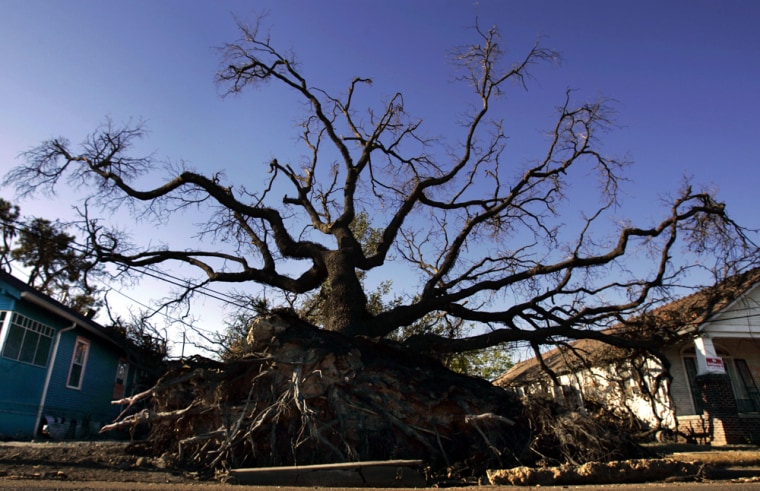The sun shines brighter in this upended New Orleans fall season. It bathes an unexpectedly leafless, wintry landscape in harsh light, even as the temperature outside still says summer.
Pouring through bare branches once thick with leaves, the sun now illuminates spots — whole city blocks Uptown — that once offered a dark green respite even on the hottest midsummer day.
Lafayette Square, Danneel playground, Camp Street, St. Charles Avenue: Katrina came through the city like giant pruning shears, wildly clipping trees that once made the city an urban forest.
Uptown didn’t flood, and most of its houses survived. But the dense canopy that shaded it is tattered. The look of these neighborhoods has been strangely altered, with structures once hidden by green now poke awkwardly out, exposed.
The symmetry of tree and house, a distinctive feature of this city, is askew. And six weeks after the storm, giant piles of branches still lie uncollected on the sides of streets.
Fallen giants still in place
Here and there, trees crashed right into the wooden houses, as at Jackson Avenue and Coliseum Street, where for weeks a tree top has ornamented someone’s second-story bedroom. The struggling city hasn’t had the wherewithal to move these trees, and no other authority has stepped up.
Tree experts say a relatively small number of Uptown’s historic trees actually tumbled during the storm. But leaf-laden branches were devastated.
“It’s shocking, now, the degree to which the live oaks have been slimmed,” said Charles Reith, a professor of environmental management at Tulane University. “In 140 mph winds, any tree is going to drop branches.”
Still, Reith and others say the picture may not be as bad as seems. Most of the historic trees in New Orleans survived, even if they were given a severe trimming, experts said. And even trees in the flood zone will likely come back.
“It looks like hell, no doubt about it,” said Hallie Dozier, an assistant professor of forestry at LSU’s school of Renewable Natural Resources, who toured the flood zone recently. “But they will probably bloom again.”
3 percent loss of historic trees
The city’s live oaks, in particular — the massive, gnarly trees that give New Orleans so much of its shade and character — braved Katrina with particular aplomb. These trees, some of them hundreds of years old, are well adapted to this storm-prone, watery environment, said Reith.
He estimates that no more than 3 percent of New Orleans’ historic trees were felled. City Park lost about 1,000 trees, said Dozier — but another 13,000 remain. Even submerged trees that now “look like chocolate trees” may leaf again. Dozier counsels patience, at least until the spring.
Pecans and water oaks, less sturdy, suffered far more than the live oaks and the light, flexible cypress, which bent with the winds, but did not break.
“The live oaks are well adapted, and New Orleanians can be assured: they will recover,” Reith said. In fact, to the surprise and even amusement of horticulturists, the live oaks are already putting out new growth, at a time of year when they are not supposed to. “Many of these trees are confused,” Reith said.
New views
Yet life won’t be the same for those in proximity to the unfortunate few that did come down. These old trees made the moment of their demise felt. For weeks after the storm, the corner of Camp and Foucher streets was blocked by a massive live oak that came down during Katrina.
When the tree fell, “it felt like an earthquake,” said Edgar Lee Smith, who rode out Katrina in his house yards away. When the storm subsided and he walked outside, “I saw a sight I’d never seen before,” said Smith, an artist. “I said, ‘What the hell is that?”’
It was the top of the old brick school building, half a block away. For the 36 years he had lived there, the building had been hidden by the giant tree’s top.
In all those years, his patch of Camp Street had been under a giant canopy. Now, it is sun-struck, and a bewildered magnolia is blooming.
“This block will never feel the same again,” Smith said.
